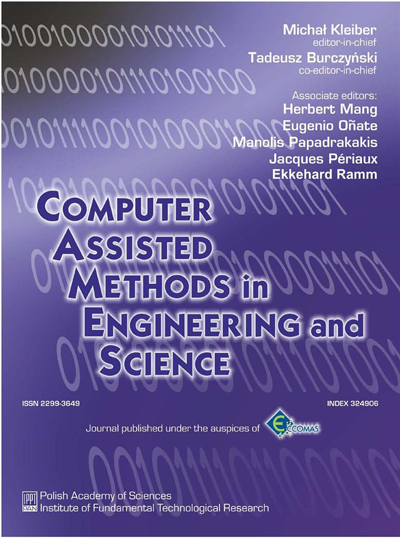Evolutionary identification of laminates' granular parameters
Abstract
The paper deals with the identification of material constants in simple and hybrid laminates. It is assumed that identified constants are non-deterministic and can be described by means of different forms of the information granularity represented by interval numbers, fuzzy numbers or random variables. The Two-Stage Granular Strategy combining global (Evolutionary Algorithm) and local (gradient method supported by an Artificial Neural Network) optimization techniques is used to solve the identification problems. Finite Element Method in the granular form is used to solve the direct problem for laminates. Modal analysis methods are employed to collect measurement data for the identification process. Numerical examples presenting effectiveness of the strategy are enclosed.
Keywords
laminate, information granularity, identification, evolutionary algorithm, artificial neural network, interval numbers, fuzzy numbers, random variables,References
[1] G. Beer. Finite element, boundary element and coupled analysis of unbounded problems in elastostastics. Int. J. Numer. Meth. Eng., 19: 567–580, 1983.[2] T. Burczyński, W. Kuś. Distributed evolutionary algorithm - tests and applications. In: Proc. AI-METH 2002, Gliwice, 2002.
[3] K. Deb. Multi-objective Genetic Algorithms: Problem Difficulties and Construction of Test Problems. Evolutionary Computation, 7(3): 205–230, 1999.
[4] K. Deb. Evolutionary Multi-Objective Optimization Without Additional Parameters. In: J. Kacprzyk, ed., Studies in Computational Intelligence, 54, pp. 241–257, Springer-Verlag, Berlin-Heidelberg, 2007.
[5] K. Deb, S. Agrawal, A. Pratap, T. Meyarivan. A Fast Elitist Multiobjective Genetic Algorithm: NSGA-II. IEEE Transactions on Evolutionary Computation, 6(2): 182–197, 2002.
[6] Documentation for ANSYS. ANSYS Inc., 2007.
[7] B. Fu, T. Hemsel, J. Wallaschek. Piezoelectric transducer design via multiobjective optimization. Ultrasonics, 44: e747–e752, 2006.
[8] L. Gaul, M. Kogl. A boundary element method for transient piezoelectric analysis. Engineering Analysis with Boundary Elements, 24: 591–598, 2000.
[9] W. Kuś. Grid-enabled evolutionary algorithm application in the mechanical optimization problems. Engineering Applications of Artificial Intelligence, 20(5): 629–636, 2007.
[10] N. Maluf, K. Williams. An introduction to microelectromechanical systems engineering. Artech House Publishers, 2004.
[11] Z. Michalewicz. Genetic algorithms + data structures = evolutionary programs. Springer-Verlag, Berlin-New York, 1996.
[12] H.F. Tiersten. Linear piezoelectric plate vibrations. Plenum Press, New York, 1969.
[13] Y. Zhang, Q. Huang, R. Li, W. Li. Macro-modeling for polysilicon cascaded bent beam electrothermal microac-tuators. Sensors and actuators A: Physical, 128(1): 165–175, 2006.
[14] O.C. Zienkiewicz, R.L. Taylor. The Finite Element Method. Butterworth-Heinemann, Oxford, 2000.
[15] E. Zitzler, M. Laumanns, L. Thiele. SPEA2: Improving the Strength Pareto Evolutionary Algorithm. TIK-Report 103, 2001.




